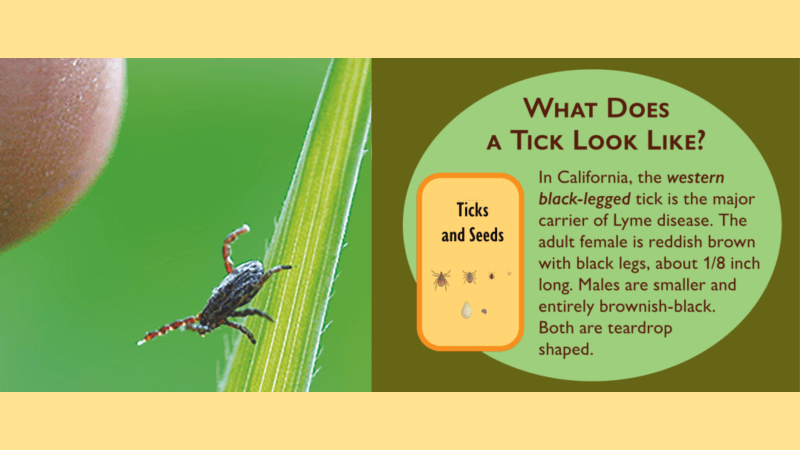Tick Season Advisory
Whether you’re hiking in East Bay Regional Parks, venturing into nearby open spaces, or simply relaxing in your own yard, it’s important to be wary of ticks, which are often present in tall grass, brush, and wooded areas. Visitors are encouraged to keep tick safety precautions in mind when visiting East Bay Regional Parks throughout the spring, summer, and fall seasons.
Ticks carry germs that can cause a number of diseases, including Lyme disease. Lyme disease is an infectious disease transmitted by the bite of a tick. It may be treated and cured with early diagnosis, but if not properly treated, it may persist in the body for years. Visit www.bayarealyme.org for more information.
What Does a Tick Look Like? In California, the western black-legged tick is the major carrier of Lyme disease. The adult female is reddish brown with black legs, about 1/8 inch long. Males are smaller and entirely brownish black. Both are teardrop shaped. Most ticks can’t fly or jump. They wait on the tips of grasses and in shrubs along well-used paths. With their front legs outstretched, they easily climb aboard unsuspecting hosts when they brush by.
Tick Safety Tips
- Wear long pants, long sleeves, and closed-toe shoes.
- Tuck shirt into pants, and pants into socks.
- Use insect repellent on shoes, socks, and pants.
- Check yourself, your children, and your pets for ticks thoroughly and frequently.
- Keep children and pets nearby. For maximum safety, consider keeping your dog on a leash.
- Stay on trails. Avoid brush and grassy areas.
What To Do If Bitten By A Tick
- Pull the tick gently from the skin using a tissue or tweezers (not with bare hands).
- Scrape to remove any mouthparts left behind. An item such as a credit card can be used.
- Wash hands and the tick bite with soap and water; apply antiseptic to the bite. Prompt removal of ticks may prevent disease transmission.
- See a physician immediately if you think you have found a tick attached to your skin and you have any of the above symptoms. Early symptoms may include a spreading rash accompanied by fever, aches, and/or fatigue.
Download the Park District’s Living with Ticks brochure. Additional information is available at ebparks.org/safety/wildlife-encounters.
The East Bay Regional Park District is the largest regional park system in the nation, comprising 73 parks, 55 miles of shoreline, and over 1,330 miles of trails for hiking, biking, horseback riding, and environmental education. The Park District receives an estimated 30 million visits annually throughout Alameda and Contra Costa counties in the San Francisco Bay Area.
###







